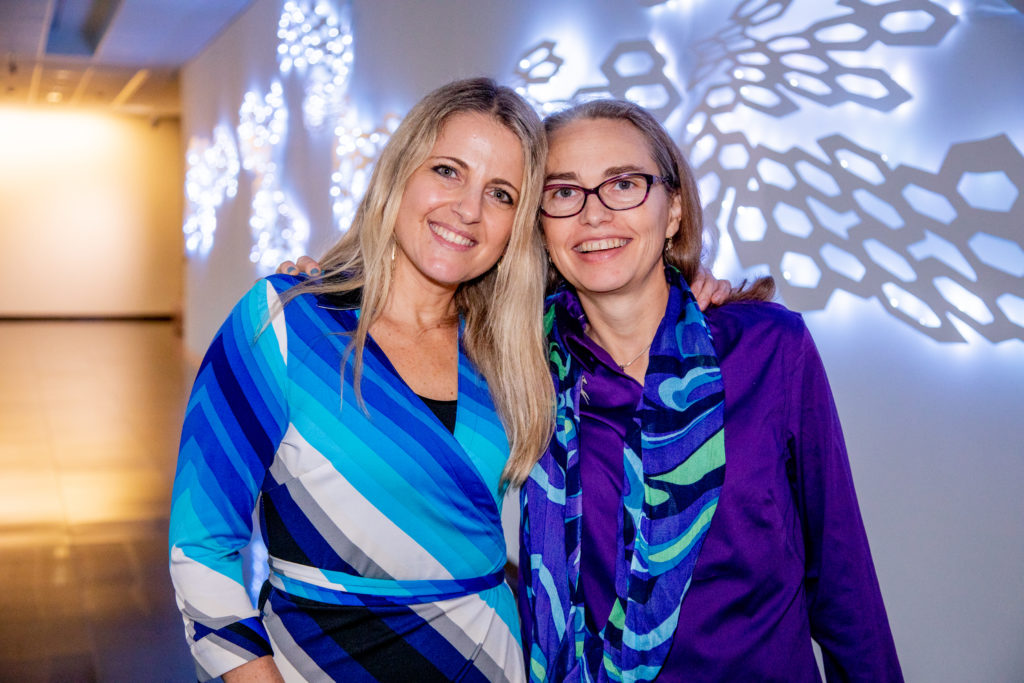When Samantha Joye and Rebecca Rutstein talk about diving in the deep ocean, it can be difficult to tell who is the scientist and who is the artist.
“There’s this sense of purity, like looking at a newborn baby. There’s this sense of awe that you get again and again during a dive,” Joye said. “But especially as you’re going down to the bottom—it’s overwhelming. You bare your soul in that submarine.”
“Going up and down in the water column was probably the most spiritual thing I’ve ever experienced,” said Rutstein, noting the movement of bioluminescent organisms that looked like “dancing stars” in the pitch black.
“My jaw dropped to the floor. I just couldn’t believe what I was seeing.”
Technically, Joye is the scientist, and Rutstein is the artist. The two came together for a public discussion during the Alliance for the Arts in Research Universities conference held on UGA’s campus in November.
Common curiosity
Scientists and artists don’t generally work together, so their paths might never have crossed. But Joye, a University of Georgia marine scientist and Georgia Athletic Association Professor in the Franklin College of Arts and Sciences, and Rutstein, a Philadelphia-based artist, have a lot in common. Both are self-described geology nerds. Both are curious about how our planet works and eager to explore places hidden from view. And both feel compelled to share what they learn. Their commonalities are apparent as they discuss their work.
Joye: “The perspective is amazing. I think you feel your humanity …”
Rutstein interjected: “You feel tiny.”
Joye: “… when you’re in the submarine. You feel [that] you’re a little speck in this incredibly diverse universe.”
Rutstein echoed the sentiment: “You’re a speck.”

Their conversation coincided with the opening of a yearlong installation of Rutstein’s work at the Georgia Museum of Art, part of her tenure as the third Delta Visiting Chair for Global Understanding, established by UGA’s Willson Center for Humanities and Arts through support from The Delta Air Lines Foundation. The Delta Chair hosts outstanding global scholars, leading creative thinkers, artists and intellectuals who teach and perform research at the university.
“The scale and diversity of UGA offer constant opportunities to put different kinds of human knowledge and creativity in conversation with each other. The Willson Center is a hub of these partnerships in which the arts, the humanities and the sciences can speak to and with each other about experiences that change how we see our world,” said Nicholas Allen, director and Franklin Professor of English. “In this case, our Delta Visiting Chair allowed us to bring Rebecca to campus to talk about her deep-sea explorations with Mandy [Joye] and to show the outcomes of that work in her sculpture and painting.”
A few weeks later, Joye and Rutstein embarked on a deep-sea expedition, taking a dive together in the Alvin, the country’s only research submersible capable of carrying humans to the sea floor. For Rutstein, it was the fulfillment of a lifelong dream. For Joye, it was an opportunity to share something special, but inaccessible to most, with an artist—someone who can translate the experience into work that will resonate with the public.
“I think this [partnership] could have a huge impact on how people see the deep ocean,” she said.
The dives never get old
Joye, who is known internationally for her work in the Gulf of Mexico after the Deepwater Horizon oil spill, has spent close to two months of her life on the bottom of the ocean (an estimated 50 to 100 dives). But it never gets old.
“I’m never going to stop discovering things,” she said. “I’m never going to stop seeing things that make my jaw hit the floor.”
After each dive, she comes back with many new ideas—and an altered outlook.
“You ever wonder what limits your imagination? Diving in submersibles and working in the ocean blasts through those walls,” she said. “You’re constantly going past your boundaries and thinking about how the world works in new and different ways.”
Joye wants to share that “gift of expansion” with others. Research at sea is a collaborative venture, she said, and everyone needs to be committed to communicating about it.
“Not everybody’s meant to be an oceanographer,” she said. “Not everybody’s meant to be an artist at sea. But for the average person, this opens their mind and their spirit and ignites their imagination.”
Connecting with people
Joye’s commitment to education led to another project that debuted in November, “The Adventures of Zack and Molly,” a three-part animated series highlighting the Gulf of Mexico and the importance of healthy oceans. The short-film series, aimed at kids, was created in partnership with artist Jim Toomey, creator of the “Sherman’s Lagoon” comic strip.
But Joye also wanted ways to connect with adults, and that’s where Rutstein comes in.
“Rebecca’s art is spiritual. It’s experiential,” she said. “It’s hard to describe the sense of awe and wonder and curiosity and imagination that it brings out in people of all ages.”
The deep sea is “magical,” but it’s also dark, cold and inhospitable, said Joye, who has spent considerable time contemplating how to share what she does with the public.
“It’s beautiful when you’re in the submarine, but it’s really hard to convey that,” she said. “When I met Rebecca, and she showed me some of her artwork, I instantly thought to myself, ‘Wow, this shines light into the darkness.’”


